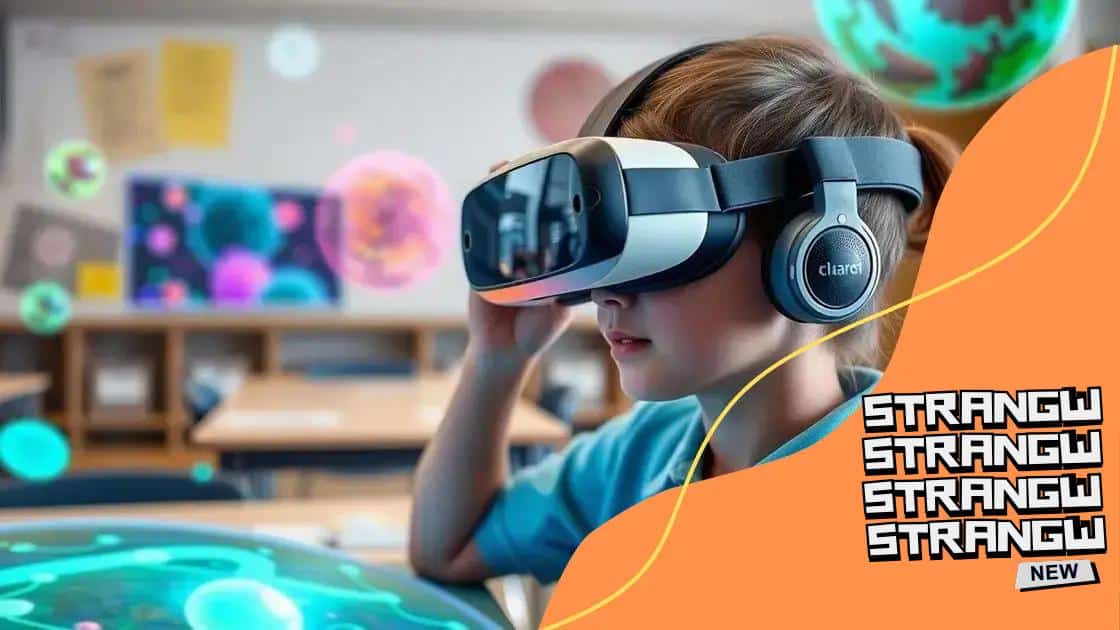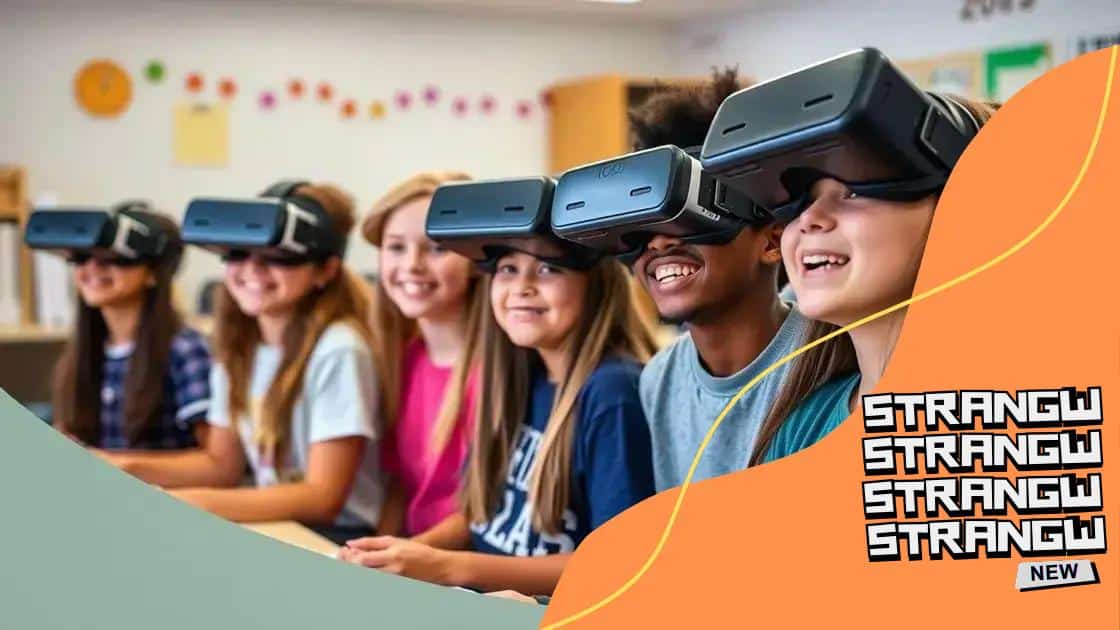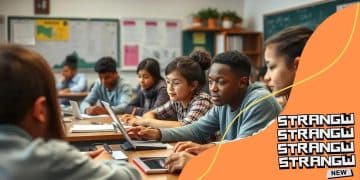Virtual reality in STEM education is changing the game

Virtual reality in STEM education enhances student engagement and understanding by providing immersive, hands-on learning experiences, while also presenting challenges such as cost and the need for proper teacher training.
Virtual reality in STEM education is transforming how students interact with complex concepts. Have you ever wondered how immersive technology can make learning more engaging and effective? Let’s dive into this fascinating topic.
Understanding virtual reality in education
Understanding virtual reality in education is essential for grasping how this technology can revolutionize learning. As schools look for innovative ways to engage students, virtual reality offers a unique solution. Imagine stepping into a world where students can explore complex environments and concepts without leaving the classroom.
What is Virtual Reality?
Virtual reality (VR) is an immersive technology that simulates real or imagined environments. By wearing VR goggles, students can experience interactive lessons that make learning more enjoyable. With the right equipment, students can literally step inside a science experiment or walk through historical events.
Benefits of Virtual Reality in Education
This technology provides numerous benefits:
- Enhanced Engagement: Students are more likely to stay focused and interested when learning through VR.
- Safe Learning Environment: VR allows students to experiment without real-world risks.
- Visual Learning: Difficult concepts become tangible, making them easier to understand.
- Customizable Experiences: Teachers can tailor VR lessons to fit their curriculum and student needs.
When incorporating virtual reality into STEM education, teachers find that students develop a deeper understanding of the subject matter. For example, instead of reading about the solar system, students can explore it firsthand. This hands-on approach empowers learners and fosters a lasting interest in STEM fields.
Additionally, virtual reality can cater to different learning styles. Visual learners thrive in immersive environments, while kinesthetic learners benefit from interactive simulations. Every student has the chance to engage with content that resonates with them.
In conclusion, understanding virtual reality in education opens doors to innovative teaching methods. As this technology continues to evolve, it will undoubtedly shape the future of learning, preparing students for a world where virtual reality plays an integral role.
The impact of virtual reality on learning outcomes
The impact of virtual reality on learning outcomes is significant. Research shows that students who learn through immersive experiences often retain information better than those who learn through traditional methods. Regular lessons can feel monotonous, but virtual reality brings subjects to life, capturing students’ interest and imagination.
How VR Improves Retention
When students engage with a lesson in a memorable way, they are more likely to remember what they have learned. For instance, by exploring a virtual lab, students can conduct experiments in a risk-free environment. This hands-on experience greatly enhances retention as students create strong mental images.
Enhanced Participation
Another advantage of virtual reality is heightened participation. Students often become active participants rather than passive observers. When they are involved, the connection to the subject matter deepens. Increased participation leads to:
- Collaborative Learning: Students often work in groups, fostering teamwork.
- Increased Motivation: The novelty of VR keeps students engaged and excited.
- Real-World Connections: VR helps students see the relevance of what they are learning.
Furthermore, studies reveal that students using VR in STEM education perform better on assessments. For example, one study found that students who used VR to learn physics concepts scored significantly higher on tests than their peers. This demonstrates the efficacy of virtual reality in improving learning outcomes.
As educators embrace this technology, the potential to transform learning experiences is immense. By incorporating virtual reality into their lessons, teachers can help students achieve greater academic success and develop a passion for learning. In conclusion, the impact of virtual reality extends beyond just engagement; it enhances learning outcomes in powerful ways.
How VR engages students in STEM fields

How VR engages students in STEM fields is an exciting area to explore. By immersing learners in virtual environments, education becomes interactive and compelling. Traditional classroom settings often limit engagement, but virtual reality breaks those boundaries.
Immersive Experiences
Virtual reality allows students to step into scenarios that relate to their studies. For example, in a VR chemistry lab, students can mix compounds safely and observe reactions in real-time. This hands-on learning experience enhances their understanding and retention of complex concepts.
Enhancing Curiosity
Another way that VR engages students is by sparking curiosity. When students are given the chance to explore space, ocean depths, or historical events, they become eager to learn more. Their natural curiosity drives them to ask questions and seek out knowledge. Here are a few specific ways VR enhances curiosity:
- Exploration: Students can visit places they wouldn’t normally be able to see.
- Interaction: Engaging with the content makes learning memorable.
- Problem-solving: Students face challenges that they need to solve using their knowledge.
Additionally, VR fosters collaboration among students. Many VR experiences allow groups to work together, boosting teamwork and communication skills. For instance, students can be part of a virtual science expedition where they must cooperate to gather data and solve problems. This social aspect of learning makes the experience even more enriching.
Furthermore, virtual reality caters to various learning styles. Kinesthetic learners thrive in hands-on activities, while visual learners benefit greatly from vivid imagery. Each student can find something that resonates with their preferred learning style, making education more inclusive. VR creates a bridge connecting theory and practical application, transforming abstract ideas into tangible experiences.
Real-world applications of virtual reality in classrooms
Real-world applications of virtual reality in classrooms are becoming increasingly popular. Schools and educators are discovering innovative ways to integrate VR into their teaching methods. This technology allows students to experience and explore concepts firsthand, creating memorable learning moments.
Field Trips Without Leaving the Classroom
One practical use of virtual reality is to take students on virtual field trips. Instead of traditional outings, students can travel to famous museums, historical sites, or even outer space. This opens up opportunities for:
- Cost-effective Exploration: Schools can save money on travel expenses.
- Access to Diverse Locations: Students can visit places that are geographically or financially out of reach.
- Enhanced Engagement: Experiencing a location through VR makes learning more exciting and relatable.
In addition to virtual field trips, VR allows students to engage in complex simulations. For instance, future surgeons can practice operations in a virtual environment, developing their skills without real-life risks. This kind of simulated practice helps students build confidence in their abilities.
Interactive Science Experiments
Another application is in science education. Students can conduct experiments that might be too dangerous or complicated in the classroom. With virtual reality, they can safely explore chemical reactions or biological processes. This hands-on approach enhances understanding and makes abstract concepts tangible.
Furthermore, VR promotes collaborative learning. Students can work on projects together in a shared virtual space, fostering teamwork and communication skills. They can brainstorm ideas, solve problems, and create presentations, all while being engaged in their lessons.
As virtual reality technology continues to evolve, its applications in education will expand. It offers exciting possibilities for engaging learning experiences that prepare students for real-world challenges. The integration of VR into classrooms represents a significant step forward in modern education.
Challenges and considerations for implementing VR
Challenges and considerations for implementing VR in education can affect how effectively it is used in classrooms. While this technology offers many benefits, there are hurdles that educators and schools must navigate. Understanding these challenges is essential for successful implementation.
Cost and Accessibility
One major challenge is the cost of VR technology and equipment. Quality headsets and software can be expensive, making it difficult for some schools to invest. Additionally, not all students may have equal access to this technology outside of school. This digital divide can limit the effectiveness of VR as a learning tool.
Training for Teachers
Another consideration is the need for teacher training. Educators must feel comfortable using VR technology before they can effectively integrate it into their lessons. Without proper training, teachers may struggle to implement VR effectively, which can lead to ineffective use or wasted resources. Providing teachers with ongoing support and training is crucial.
Content Quality and Curriculum Integration
Quality content is also vital for successful integration. Schools need to ensure that the VR experiences they choose are educational and aligned with their curriculum. Not all VR apps are created equal, so it’s important to evaluate options properly. Integration into the curriculum should feel seamless and enhance existing learning opportunities.
Moreover, not every subject may benefit equally from VR technology. Teachers must consider whether it truly enhances learning in their specific subject areas. Finding relevant content that meets educational goals can be a challenge in itself.
Finally, technical issues can also impact VR implementation. Schools need reliable internet access and technical support to address potential problems. If students encounter issues during a lesson, it can disrupt the learning process and diminish the excitement surrounding VR learning.
FAQ – Frequently Asked Questions about Virtual Reality in Education
What are the main benefits of using VR in classrooms?
Using VR in classrooms increases student engagement, enhances understanding of complex concepts, and allows for immersive, hands-on learning experiences.
What challenges do schools face when implementing VR?
Schools face challenges like high costs, the need for teacher training, content quality, and ensuring accessibility for all students.
How can VR improve learning outcomes?
VR provides immersive experiences that can help students better retain information and actively participate in their learning, boosting overall academic performance.
Is VR suitable for all subjects?
While VR can enhance learning in many subjects, its effectiveness may vary. Educators need to select relevant VR content that aligns with their curriculum.





